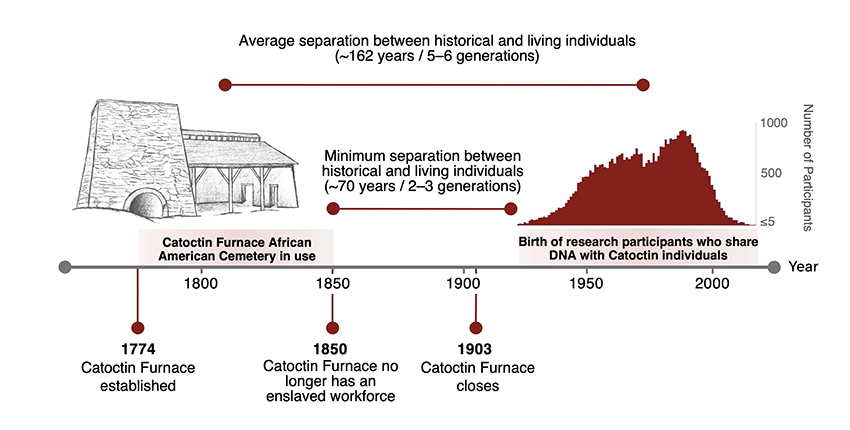Historical DNA Study Connects Living People to Enslaved and Free African Americans at Early Ironworks

[ad_1]
Answers in ancient DNA
The new method — developed by a team led by Reich and first author Éadaoin Harney, a population geneticist at 23andMe, for the study — analyzes DNA segments that are shared by two or more people because they were inherited from a recent common ancestor. For example, cousins may have identical DNA segments inherited from a shared grandparent.
“The more identical DNA segments a person shares, and the longer those segments are, the more likely they are to be a very close relative,” the authors explained.
Using this method, the team found that 41,799 of the research participants are genetically related to one or more of the 27 sequenced individuals from Catoctin Furnace.
Of them, 2,975 participants were deemed close relatives of Catoctin individuals because they shared more than 0.4 percent of their genomes (not counting sex chromosomes). This ranged from five degrees of separation — the same amount as a great-great-great-grandchild — to about nine degrees, or the equivalent of first cousins six times removed.
The research doesn’t yet reveal which, if any, of these close relatives descend from the Catoctin individuals and which are related in less direct ways.
Because the 23andMe database included geographic information, the study team was able to determine that Maryland has the highest concentration of close relatives, revealing that some relatives did not move far from Catoctin Furnace as the generations passed.
“This study represents a step toward meeting our ultimate goal of identifying a Catoctin descendant community using DNA and other tools,” said co-author Elizabeth Comer of the Catoctin Furnace Historical Society.
The majority of participants, though, appear to be distant relatives. The authors suspect many of their connections to Catoctin individuals stretch back to shared ancestors who lived in Africa or Europe during or before the transatlantic slave trade.

“Following on a 2020 study looking at the genetic impact of the transatlantic slave trade, we are privileged to contribute to an increased understanding of the impact of slavery on those in bondage, their descendants, and their unacknowledged contributions to American history,” said co-senior author Joanna Mountain, formerly of 23andMe.
Genomes enrich the tale
Beyond relatedness to present-day people, the study uncovered information about those who lived and worked at Catoctin Furnace that thus far had remained unknowable using other techniques.
The researchers found that the Catoctin individuals descended from a small number of African groups, particularly the Wolof and Mandinka of Senegambia in West Africa and the Kongo of Central Africa.
These results align with statistics in the Trans-Atlantic Slave Trade Database, which show that about 25 percent of African American ancestors were shipped to North America from Senegambia and another 25 percent from Kongo-Angola, said Gates.
The genetic findings bolster knowledge about where in Africa different groups of enslaved people in the early U.S. came from. Such knowledge is harder to glean from the DNA of African Americans today because of mixing over many generations.
Many of the Catoctin individuals had some European ancestry, mainly from Britain and Ireland and mainly on the paternal side. This aligns with known histories of sexual exploitation of enslaved people by their enslavers and others in positions of power, the authors said.

The team found that 15 of the Catoctin individuals could be grouped into five genetic families. These families consisted mostly of mothers, children, and siblings buried close together.
The analyses also revealed that several of the Catoctin individuals carried risk factors for sickle cell anemia and G6PD deficiency, two genetic disorders marked by red blood cell abnormalities that are still common among African Americans.
“This work helps restore the personal stories of those connected with the site,” said Reich.
Just the beginning
While the findings are illuminating for those interested in and connected with Catoctin Furnace, the study also opens a wider door to analyzing identical-by-descent DNA segments and comparing historical or ancient DNA with personal genome databases to deepen understanding of human history.
“Methodologically, this work represents a step forward for enabling further study of the biogeographic origins and genetic legacy of historical African American populations, particularly in cases where documentation is limited, as is common,” said Gates.
Added Reich, “This approach could be applied to DNA from any ancient or historical individual to learn about their past and how they relate to those who live today.”

Authorship, funding, disclosures
Reich and Mountain are co-senior authors with Douglas Owsley, curator of biological anthropology at the Smithsonian’s National Museum of Natural History. Reich is an investigator at the Howard Hughes Medical Institute. Gates serves as a consultant on African American and African history to 23andMe.
First author Harney earned her PhD from the Harvard Griffin GSAS in the labs of Reich and geneticist John Wakeley.
Additional authors are Steven Micheletti, Karin S. Bruwelheide, William A. Freyman, Katarzyna Bryc, Ali Akbari, Ethan Jewett, Linda Heywood, John Thornton, Samantha Ancona Esselmann, Kathryn G. Barca, Jakob Sedig, Kendra Sirak, Iñigo Olalde, Nicole Adamski, Rebecca Bernardos, Nasreen Broomandkhoshbacht, Matthew Ferry, Lijun Qiu, Kristin Stewardson, J. Noah Workman, Fatma Zalzala, Shop Mallick, Adam Micco, Matthew Mah, Zhao Zhang, 23andMe Research Team, and Nadin Rohland.
The ancient DNA analysis was funded by the National Institutes of Health (grant HG012287), John Templeton Foundation (grant 61220), and Howard Hughes Medical Institute. The pedigree analysis was funded in part by NIH grant R35GM133805. In 2016, a $14,000 Maryland Heritage Areas Authority grant was awarded to CFHS to fund forensic research for the African American cemetery. The Rice Family Endowment for Forensic Anthropology provided critical support for Smithsonian Skeletal Biology Program contributions.
Harney, Micheletti, Freyman, Bryc, Jewett, Esselmann, Mountain, and members of the 23andMe Research Team are employees of and have stock, stock options, or both in 23andMe. The remaining authors declare no competing interests.
Adapted from materials by the Smithsonian and 23andMe.
[ad_2]
Source link
